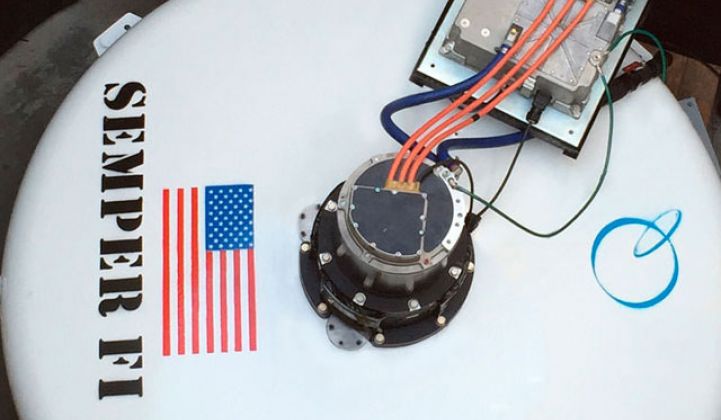In 2013, Camp Pendleton was awarded $1.7 million from the California Energy Commission for a microgrid demonstration project to be sited at the San Diego military base.
The project, called FractalGrid, involves smaller microgrids, such as a parking garage and server room, within a larger microgrid that covers the base and can island from the utility grid. Distributed assets include solar PV, diesel generators, batteries and the first test of a new flywheel technology from Quantum Energy Storage.
"This project will evaluate new and emerging technologies in a real-world environment while providing reliable and secure energy to the military base at Camp Pendleton," Energy Commission Chair Robert Weisenmiller said at the time of the funding in 2013.
The Camp Pendleton microgrid, with CleanSpark as system designer and implementer, is testing Quantum Energy’s 60-kilowatt, 120-kilowatt-hour flywheel system. Compared to other flywheels, the steel design is closer to a flywheel pancake than a traditional cylinder. It is less than 2 feet thick and runs at a much lower rate of rotations per minute (RPM), about 6,000, compared to flywheels from Temporal Power and Beacon Power, which run at more than 10,000 RPM.
The alternative design, which includes off-the-shelf components such as an electric-vehicle motor inverter, allows for a lower cost, according to Eric Martinez, senior systems engineer with Quantum Energy.
The lower RPM reduces damage that can come from resonance at high RPMs and therefore reduces the odds of failure, he added. If there is a component failure, the disc can just spin down and grind itself to a halt.
In addition to the novel design, Quantum Energy also developed its own software to monitor and control the flywheel. For the project in Pendleton, the company can change the algorithms as needed to operate it differently based on various parameters, such as providing long-term backup power or energy to shave peaks.
Martinez said the company's design is highly customizable at a low cost in microgrids because it can easily be integrated with other distributed assets such as solar PV or building systems. Although Quantum's software can integrate with other assets, for the Pendleton project CleanSpark is integrating the various assets in the microgrid.
The Poway, Calif.-based company is also planning for a larger flywheel in the future that could drive down the cost of the unit. Martinez would not give specifics on current cost, but said the 100-kilowatt-hour unit is comparable to lithium-ion battery systems. The company has an eventual price target of less than $150 per kilowatt-hour.
A flywheel for more than grid balancing
Most flywheels are in the business of providing grid services to utilities on the multi-megawatt scale, primarily frequency regulation, but Quantum Energy sees many other applications for its technology.
The company is in talks with the government of South Africa to pilot its system as backup power during rolling blackouts, and also to provide voltage support. It would not necessarily supplant diesel backup, but rather reduce the reliance on diesel.
“Storage has gained increasing traction as isolated communities move to diversify away from conventional generation and reduce costs associated with fuel price uncertainty and transportation logistics,” says Omar Saadeh, senior analyst with GTM Research and author of the recent report, North American Microgrids 2015: Advancing Beyond Local Energy Optimization.
Quantum Energy has been testing its ability to provide long-term backup power at Pendleton, providing 10 hours of backup power overnight to the parking garage. During the day, it provides power for elevators, which are a substantial power draw, to reduce peaks to its energy system. The company says its flywheel can also provide grid balancing, although it is not performing that function at Pendleton.
In remote communities, Martinez said the payback could be as little as one year. For places like the Caribbean with high power prices (close to $0.40 cents per kilowatt-hour), the payback for Quantum Energy’s system is about three to five years when replacing diesel gensets, according to the company. The firm is working with financial partners to offer power-purchase agreements with no upfront cost.
The startup has raised about $6 million in funding from private investors and is helmed by Tien Nguyen, formerly of Qualcomm and CommASIC and most recently with On-Ramp Wireless.
Although the company is just coming out of stealth mode, it already gained local media coverage earlier this summer after a “significant” explosion at its manufacturing facility. At the time, Nguyen said that a mechanical issue led to the accident and it was not related to the flywheel. Quantum Energy did not comment further when asked about the explosion.



